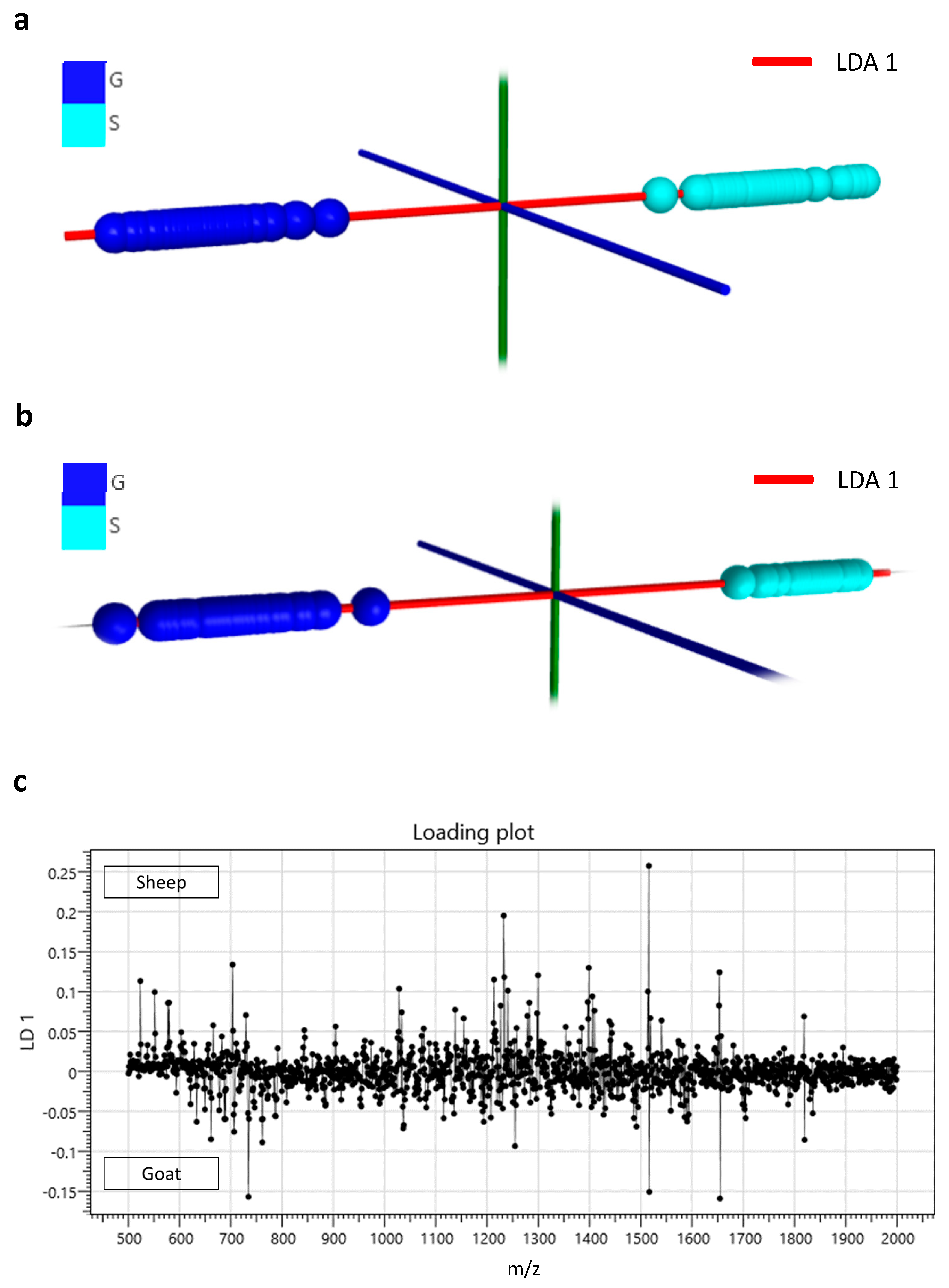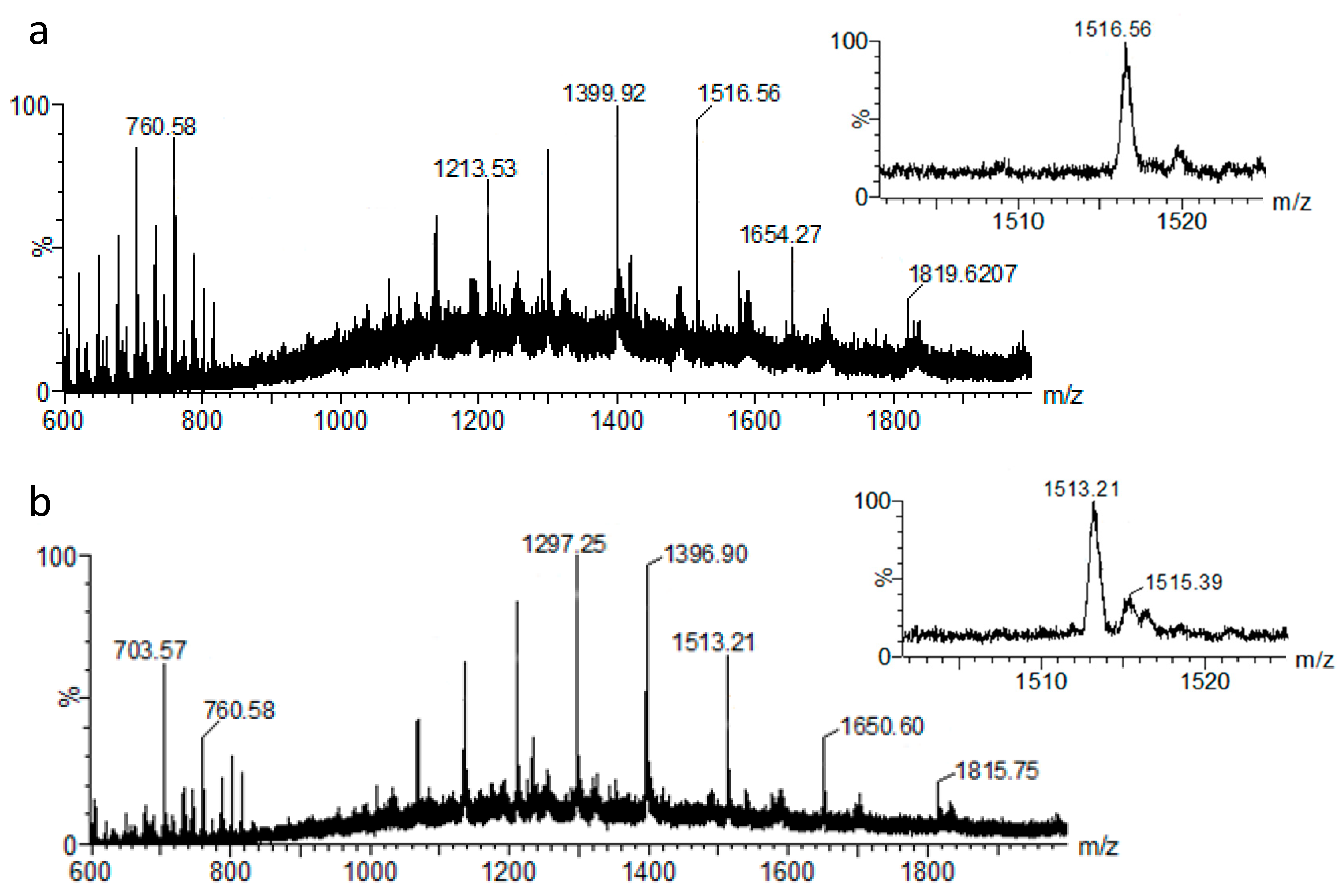Rapid Liquid AP-MALDI MS Profiling of Lipids and Proteins from Goat and Sheep Milk for Speciation and Colostrum Analysis
Abstract
1. Introduction
2. Materials and Methods
2.1. Sample Collection
2.2. Milk Sampling for Goat/Sheep Speciation
2.3. Colostrum Sampling
2.4. Conventional Milk Sample Analysis
2.5. Sample Preparation for MS Analysis
2.6. MS Analysis
2.7. MS Profile Data Analysis
2.8. MS/MS Analysis
3. Results
4. Discussion
5. Conclusions
Author Contributions
Funding
Acknowledgments
Conflicts of Interest
References
- Pandya, A.; Ghodke, K. Goat and sheep milk products other than cheeses and yoghurt. Small Rumin. Res. 2007, 68, 193–206. [Google Scholar] [CrossRef]
- López-Calleja, I.; González, I.; Fajardo, V.; Martín, I.; Hernández, P.; García, T.; Martín, R. Quantitative detection of goats’ milk in sheep’s milk by real-time PCR. Food Control 2007, 18, 1466–1473. [Google Scholar] [CrossRef]
- Roncada, P.; Piras, C.; Soggiu, A.; Turk, R.; Urbani, A.; Bonizzi, L. Farm animal milk proteomics. J. Proteom. 2012, 75, 4259–4274. [Google Scholar] [CrossRef] [PubMed]
- De La Fuente, M.A.; Juárez, M. Authenticity assessment of dairy products. Crit. Rev. Food Sci. Nutr. 2005, 45, 563–585. [Google Scholar] [CrossRef] [PubMed]
- Soggiu, A.; Roncada, P.; Piras, C. Proteomics in milk and dairy products. In Proteomics in Domestic Animals: From Farm to Systems Biology; Springer: Cham, Switzerland, 2018; pp. 169–193. [Google Scholar]
- Molina, E.; Martín-Álvarez, P.J.; Ramos, M. Analysis of cows’, ewes’ and goats’ milk mixtures by capillary electrophoresis: Quantification by multivariate regression analysis. Int. Dairy J. 1999, 9, 99–105. [Google Scholar] [CrossRef]
- Chianese, L.; Laezza, P.; Smaldone, L.; Stingo, C.; Del Giovine, L.; Addeo, F. Evaluation of bovine milk in the buffalo mozzarella cheese by two-dimensional electrophoresis. Sci. Tec. Latt.-Casearia 1990, 41, 315–326. [Google Scholar]
- Ferreira, I.M.; Caçote, H. Detection and quantification of bovine, ovine and caprine milk percentages in protected denomination of origin cheeses by reversed-phase high-performance liquid chromatography of beta-lactoglobulins. J. Chromatogr. A 2003, 1015, 111–118. [Google Scholar] [CrossRef]
- Sánchez-Macías, D.; Moreno-Indias, I.; Castro, N.; Morales-delaNuez, A.; Argüello, A. From goat colostrum to milk: Physical, chemical, and immune evolution from partum to 90 days postpartum. J. Dairy Sci. 2014, 97, 10–16. [Google Scholar] [CrossRef]
- Argüello, A.; Castro, N.; Alvarez, S.; Capote, J. Effects of the number of lactations and litter size on chemical composition and physical characteristics of goat colostrum. Small Rumin. Res. 2006, 64, 53–59. [Google Scholar] [CrossRef]
- Nocek, J.; Braund, D.; Warner, R. Influence of neonatal colostrum administration, immunoglobulin, and continued feeding of colostrum on calf gain, health, and serum protein. J. Dairy Sci. 1984, 67, 319–333. [Google Scholar] [CrossRef]
- Marnila, P.; Korohnen, H. Colostrum. In Encyclopedia of Dairy Sciences; Elsevier: Amsterdam, The Netherlands, 2002; ISBN 978-0-12-227235-6. Available online: https://www.sciencedirect.com/referencework/9780122272356/encyclopedia-of-dairy-sciences#book-info (accessed on 18 August 2020).
- McMartin, S.; Godden, S.; Metzger, L.; Feirtag, J.; Bey, R.; Stabel, J.; Goyal, S.; Fetrow, J.; Wells, S.; Chester-Jones, H. Heat treatment of bovine colostrum. I: Effects of temperature on viscosity and immunoglobulin G level. J. Dairy Sci. 2006, 89, 2110–2118. [Google Scholar] [CrossRef]
- Gapper, L.W.; Copestake, D.E.; Otter, D.E.; Indyk, H.E. Analysis of bovine immunoglobulin G in milk, colostrum and dietary supplements: A review. Anal. Bioanal. Chem. 2007, 389, 93–109. [Google Scholar] [CrossRef] [PubMed]
- Gelsinger, S.; Smith, A.; Jones, C.; Heinrichs, A.J. Comparison of radial immunodiffusion and ELISA for quantification of bovine immunoglobulin G in colostrum and plasma. J. Dairy Sci. 2015, 98, 4084–4089. [Google Scholar] [CrossRef] [PubMed]
- Lopreiato, V.; Ceniti, C.; Trimboli, F.; Fratto, E.; Marotta, M.; Britti, D.; Morittu, V.M. Evaluation of the capillary electrophoresis method for measurement of immunoglobulin concentration in ewe colostrum. J. Dairy Sci. 2017, 100, 6465–6469. [Google Scholar] [CrossRef]
- Quigley, J.D.; Lago, A.; Chapman, C.; Erickson, P.; Polo, J. Evaluation of the Brix refractometer to estimate immunoglobulin G concentration in bovine colostrum. J. Dairy Sci. 2013, 96, 1148–1155. [Google Scholar] [CrossRef]
- Bartier, A.; Windeyer, M.; Doepel, L. Evaluation of on-farm tools for colostrum quality measurement. J. Dairy Sci. 2015, 98, 1878–1884. [Google Scholar] [CrossRef]
- Abraham, R.S.; Barnidge, D.R.; Lanza, I.R. Assessment of proteins of the immune system. In Clinical Immunology: Principles and Practice, 4th ed.; Elsevier Inc.: Philadelphia, PA, USA, 2012; pp. 1145–1159. [Google Scholar]
- Calvano, C.D.; De Ceglie, C.; Aresta, A.; Facchini, L.A.; Zambonin, C.G. MALDI-TOF mass spectrometric determination of intact phospholipids as markers of illegal bovine milk adulteration of high-quality milk. Anal. Bioanal. Chem. 2013, 405, 1641–1649. [Google Scholar] [CrossRef]
- Cramer, R.; Pirkl, A.; Hillenkamp, F.; Dreisewerd, K. Liquid AP-UV-MALDI enables stable ion yields of multiply charged peptide and protein ions for sensitive analysis by mass spectrometry. Angew. Chem. Int. Ed. 2013, 52, 2364–2367. [Google Scholar] [CrossRef]
- Wiangnon, K.; Cramer, R. Liquid MALDI MS analysis of complex peptide and proteome samples. J. Proteome Res. 2016, 15, 2998–3008. [Google Scholar] [CrossRef]
- Ryumin, P.; Cramer, R. The composition of liquid atmospheric pressure matrix-assisted laser desorption/ionization matrices and its effect on ionization in mass spectrometry. Anal. Chim. Acta 2018, 1013, 43–53. [Google Scholar] [CrossRef]
- Ryumin, P.; Brown, J.; Morris, M.; Cramer, R. Investigation and optimization of parameters affecting the multiply charged ion yield in AP-MALDI MS. Methods 2016, 104, 11–20. [Google Scholar] [CrossRef]
- Marty, M.T.; Baldwin, A.J.; Marklund, E.G.; Hochberg, G.K.; Benesch, J.L.; Robinson, C.V. Bayesian deconvolution of mass and ion mobility spectra: From binary interactions to polydisperse ensembles. Anal. Chem. 2015, 87, 4370–4376. [Google Scholar] [CrossRef]
- European Commission. Commission regulation (EC) No 273/2008 of 5 March 2008 laying down detailed rules for the application of council regulation (EC) no. 1255/1999 as regards methods for the analysis and quality evaluation of milk and milk products. OJEC 2008, 88, 1–115. [Google Scholar]
- Morand-Fehr, P.; Fedele, V.; Decandia, M.; Le Frileux, Y. Influence of farming and feeding systems on composition and quality of goat and sheep milk. Small Rumin. Res. 2007, 68, 20–34. [Google Scholar] [CrossRef]
- Park, Y.; Juárez, M.; Ramos, M.; Haenlein, G. Physico-chemical characteristics of goat and sheep milk. Small Rumin. Res. 2007, 68, 88–113. [Google Scholar] [CrossRef]
- Hale, O.J.; Morris, M.; Jones, B.; Reynolds, C.K.; Cramer, R. Liquid atmospheric pressure matrix-assisted laser desorption/ionization mass spectrometry adds enhanced functionalities to MALDI MS profiling for disease diagnostics. ACS Omega 2019, 4, 12759–12765. [Google Scholar] [CrossRef] [PubMed]
- Palmblad, M.; BindschedLer, L.V.; Cramer, R. Quantitative proteomics using uniform 15N-labeling, MASCOT, and the trans-proteomic pipeline. Proteomics 2007, 7, 3462–3469. [Google Scholar] [CrossRef] [PubMed]
- Towers, M.W.; Mckendrick, J.E.; Cramer, R. Introduction of 4-chloro-α-cyanocinnamic acid liquid matrices for high sensitivity UV-MALDI MS. J. Proteome Res. 2010, 9, 1931–1940. [Google Scholar] [CrossRef]
- Krenkel, H.; Hartmane, E.; Piras, C.; Brown, J.; Morris, M.; Cramer, R. Advancing Liquid Atmospheric Pressure Matrix-Assisted Laser Desorption/Ionization Mass Spectrometry Toward Ultrahigh-Throughput Analysis. Anal. Chem. 2020, 92, 2931–2936. [Google Scholar] [CrossRef]
- Calvano, C.D.; Jensen, O.N.; Zambonin, C.G. Selective extraction of phospholipids from dairy products by micro-solid phase extraction based on titanium dioxide microcolumns followed by MALDI-TOF-MS analysis. Anal. Bioanal. Chem. 2009, 394, 1453–1461. [Google Scholar] [CrossRef]
- Lellman, S.E.; Cramer, R. Bacterial identification by lipid profiling using liquid atmospheric pressure matrix-assisted laser desorption/ionization mass spectrometry. Clin. Chem. Lab. Med. (CCLM) 2019, 58, 930–938. [Google Scholar] [CrossRef] [PubMed]
- Li, M.; Li, W.; Wu, J.; Zheng, Y.; Shao, J.; Li, Q.; Kang, S.; Zhang, Z.; Yue, X.; Yang, M. Quantitative lipidomics reveals alterations in donkey milk lipids according to lactation. Food Chem. 2020, 310, 125866. [Google Scholar] [CrossRef] [PubMed]
- Martín, M.J.; Martín-Sosa, S.; Hueso, P. Bovine milk gangliosides: Changes in ceramide moiety with stage of lactation. Lipids 2001, 36, 291–298. [Google Scholar] [CrossRef] [PubMed]
- Contarini, G.; Povolo, M.; Pelizzola, V.; Monti, L.; Bruni, A.; Passolungo, L.; Abeni, F.; Degano, L. Bovine colostrum: Changes in lipid constituents in the first 5 days after parturition. J. Dairy Sci. 2014, 97, 5065–5072. [Google Scholar] [CrossRef] [PubMed]
- Cui, N.; Wen, P.; Liang, Q.; Liu, H.; Zhang, W.; Wang, P.; Guo, H.; Ren, F. Chemical composition of yak colostrum and transient milk. J. Anim. Physiol. Anim. Nutr. 2015, 99, 825–833. [Google Scholar] [CrossRef] [PubMed]
- Mancini, G.J.A.J.; Carbonara, A.T.; Heremans, J.F. Immunochemical quantitation of antigens by single radial immunodiffusion. Immunochemistry 1965, 2, 235–254. [Google Scholar] [CrossRef]




| Samples | Data Description | Fat (%) | Crude Protein (%) | Lactose (%) | Casein (%) | Cryoscopy (mC) | Urea (mg/dL) | True Protein (%) | Acetone (mM) | β-hydroxy-butyrate (mM) |
|---|---|---|---|---|---|---|---|---|---|---|
| Goat | Mean | 5.49 | 3.97 | 4.66 | 3.05 | 540 | 52.75 | 3.68 | 0.06 | 0.02 |
| (n = 43) | SD * | 1.43 | 0.53 | 0.21 | 0.44 | 9 | 13.77 | 0.52 | 0.08 | 0.03 |
| Sheep | Mean | 6.6 | 5.35 | 4.71 | 4.03 | 564 | 40.67 | 4.97 | 0.27 | 0.15 |
| (n = 44) | SD * | 0.98 | 0.6 | 0.4 | 0.46 | 20 | 9.97 | 0.59 | 0.26 | 0.17 |
| Ion Bin(m/z) | Peak m/z Values (Monoisotopic) | Theoretical m/z Values (Monoisotopic) | Putative Lipid Assignment |
|---|---|---|---|
| 523.5 | 523.47 | 523.48 | [Cer(d32:3) + NH4]+ |
| 675.5 | 675.51 | 675.53 | [SM(D16:1/16:0) + H]+ |
| 703.5 | 703.57 | 703.57 | [SM(34:1;O2) + H]+ |
| 706.5 | 706.55 | 706.54 | [PC(30:0) + H]+ |
| 734.5 | 734.57 | 734.57 | [PE(34:4) + Na]+ |
| 787.5 | 787.63 | 787.63 | [SM(40:1;O2) + H]+ |
| 788.5 | 788.62 | 788.62 | [PC(36:1) + H]+ |
| 800.5 | 801.68 | 801.67 | [SM(d41:1) + H]+ |
| 815.5 | 815.69 | 815.70 | [SM(42:1)+ H]+ |
© 2020 by the authors. Licensee MDPI, Basel, Switzerland. This article is an open access article distributed under the terms and conditions of the Creative Commons Attribution (CC BY) license (http://creativecommons.org/licenses/by/4.0/).
Share and Cite
Piras, C.; Ceniti, C.; Hartmane, E.; Costanzo, N.; Morittu, V.M.; Roncada, P.; Britti, D.; Cramer, R. Rapid Liquid AP-MALDI MS Profiling of Lipids and Proteins from Goat and Sheep Milk for Speciation and Colostrum Analysis. Proteomes 2020, 8, 20. https://doi.org/10.3390/proteomes8030020
Piras C, Ceniti C, Hartmane E, Costanzo N, Morittu VM, Roncada P, Britti D, Cramer R. Rapid Liquid AP-MALDI MS Profiling of Lipids and Proteins from Goat and Sheep Milk for Speciation and Colostrum Analysis. Proteomes. 2020; 8(3):20. https://doi.org/10.3390/proteomes8030020
Chicago/Turabian StylePiras, Cristian, Carlotta Ceniti, Evita Hartmane, Nicola Costanzo, Valeria Maria Morittu, Paola Roncada, Domenico Britti, and Rainer Cramer. 2020. "Rapid Liquid AP-MALDI MS Profiling of Lipids and Proteins from Goat and Sheep Milk for Speciation and Colostrum Analysis" Proteomes 8, no. 3: 20. https://doi.org/10.3390/proteomes8030020
APA StylePiras, C., Ceniti, C., Hartmane, E., Costanzo, N., Morittu, V. M., Roncada, P., Britti, D., & Cramer, R. (2020). Rapid Liquid AP-MALDI MS Profiling of Lipids and Proteins from Goat and Sheep Milk for Speciation and Colostrum Analysis. Proteomes, 8(3), 20. https://doi.org/10.3390/proteomes8030020








